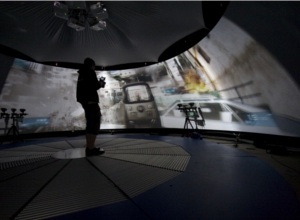By Joel Smart (The Cascade) – Email
Print Edition: November 2, 2011
Imagine the ultimate gaming simulator. What new aspects would it bring to a game that isn’t captured with a standard television and controller? Perhaps it would have more power to excite you. Maybe it would allow your actions to be more accurately portrayed in the game. As gamers become older and richer, some are beginning to explore these avenues in their quest to create the best possible gaming experience.
Dedicated racing fans now have the option to invest in motion-simulating game chairs that are programmed to automatically tilt forward, backward, and even side-to-side as the car accelerates or decelerates to accurately portray the feelings of G-forces. In order to capture the feeling of being pushed back in your seat by pushing down on the gas pedal, these seats lean way back. Going around a corner? The seat will tilt to the side to make sure you’re really feeling the pull. Some of them will even react quite violently if you crash or roll your car. In order to sustain the illusion, these setups have high definition television screens attached to them that move along with the seat.
Such driving simulators are expensive, but it’s nothing compared to the whopping £500,000 ($650,000) that Jason Bradbury and Suzi Perry, of the UK television program The Gadget Show, spent creating the ultimate game simulator for first-person-shooter (FPS) Battlefield 3. “The idea for the simulator came in July this year,” a press release for the device read, “when The Gadget Show realized that graphically-sophisticated games are held back only by the way many of us play them – sat in front of one static monitor.” While spending so much on a glorified controller seems excessive, this state-of-the-art device is so advanced it actually reinvents the boundaries of interactive media as a whole.
From the outside it looks like a grey ten-person tent. But inside, the Igloo Vision dome is a 360-degree screen four meters high and nine meters wide that can display video in every direction using five-separate projectors working in tandem. Impressive, but the next part is what really sets it apart.
At the center of the dome is an omni-directional treadmill. Picture a pizza cut up into 16-slices, with each slice being its own treadmill. Players stand on a small platform at the centre of the “pizza” and are free to walk in any direction they choose. Because each slice is composed of a great number of tiny rollers that are constantly spinning back towards the platform, they always end up back on the platform. With the use of 10 infra-red motion tracking cameras, the motions, directions and speed of the player are all captured and translated on-screen. This ground-breaking tool was designed by MSE Weibull, a Swedish-based company that, according to their website, “specializes in creating the hardware for simulators and other training devices.”
It’s an innovation that opens the doors to a new generation of virtual reality, especially considering the same cameras can track the movement of a wireless gun peripheral, which can be used to move the camera around the 360-degree screen. Because the image only occupies 180-degrees of the screen at a time, this rotational ability ensures that players can always see the area of the world they’re aiming at. The rest of the dome is lit up with an LED lighting display that uses advanced technology to detect the appropriate lighting based on the details in the game, whether it’s to light up an outdoor scene, or reflect the grungy feel of a dark corridor. A hacked Xbox 360 Kinect camera was also used to detect if a player jumped, crouched, or grabbed a fallen player in-game, adding to the immersion players felt in controlling the game.
As if that wasn’t enough, the simulator also packs in 12 paintball guns aimed at the player from various locations around the dome. Sustain enemy fire and the guns will shoot the player with rubber pellets from the exact angle they were shot at from in the game. It’s enough of a punishment to make players think twice before running out into the open.
It’s pretty incredible that such technologies even exist, and it is envy-inducing to think that some players are lucky enough to incorporate them into the video games they play. Perhaps, though, that as such technology becomes more common place, the price will go down and similar simulators may become available at the local arcade. At the very least, they provide new fodder for gamer fantasies everywhere.




